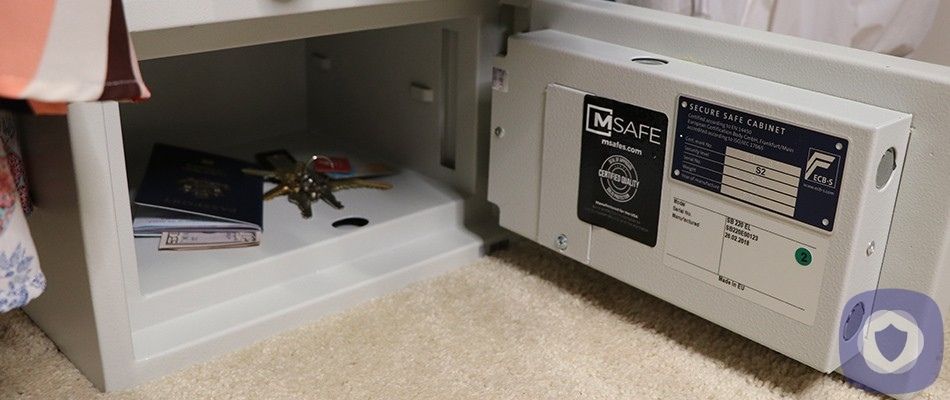Every year, millions of Americans are the victims of home burglaries and fires. Criminals find a way in or houses go up in flames along with valuables, priceless family heirlooms and important documents. To help protect their possessions, many people purchase a home safe, which is great… if they choose the right safe.
The problem is that most consumers have no idea how to correctly choose a reliable safe with the appropriate protections. Their purchase can give them a false sense of security, when in reality, their possessions are still vulnerable. So, how do you choose an effective safe? SecurityNerd spoke with Dov Israeli, Principal at Precision Lock & Safe, Inc. and MSafes, who breaks down the basics.
What to know before you shop for a safe
Buying a safe is a lot different than buying most products, Israeli says. For starters, there’s no regulation as to what can be called a safe, so there’s a wide range of protection offered by different products. Also, consumers are conditioned to shop for the lowest prices, and many rely on online reviews as well the look and feel of a product to help them make purchasing decisions. But that doesn’t work when it comes to home safes.
“People can knock and tap on safes and try to lift them, but that tells them nothing,” Israeli says. “A safe can sound or look solid, but that doesn’t tell you how much protection it offers.”
He says while consumer reviews tell you that a customer likes the way a safe looks or that it’s user-friendly, they don’t tell you the most important thing—whether or not it will truly protect you from loss. He says there are significant differences between safes that the average consumer can’t tell even when they touch and feel them.
“In quality safes, it’s what you can’t see that really matters,” Israeli says.
Unfortunately, he says many companies prey on unsuspecting consumers, and convince them to buy safes that don’t offer the protection they need.
So, how do you know if you’re buying a glorified box or a true safety device that will protect your valuables from theft and fire? Israeli says that all comes down to two important factors: certifications and standards.
Safe certifications and standards
If a safe doesn’t carry a certification or isn’t constructed to a standard, then you have no idea how it will perform under various conditions, such as fire and burglary. Certifications and standards offer the reassurance that a safe has been tested against various threats and has been shown to withstand them for a certain amount of time. Fire and burglary certifications are issued separately. That means even though a safe may offer excellent fire protection, it means nothing as to how effective it is against burglary. If you’re looking for both theft and fire protection, make sure you select a safe that carries certifications and is constructed to protect against both.
UL certifications (those performed by the Underwriters Lab) are the most stringent and pervasive in the United States. For fire, they let consumers know how long a safe has been tested to withstand heat and maintain a maximum internal temperature. For example, a UL 350 1-hour certification means a safe would keep the internal temperature below 350 degrees Farenheit for an hour when exposed to a 1700-degree fire. That doesn’t mean a safe would combust or disintegrate after an hour, but rather that at full fire temperature, the contents of the safe won’t be compromised for that amount of time.
Digital media, like hard drives and CDs require a FIRE safe certified to keep the internal temperature even lower (125 degrees), and there are special data safes for their storage, but they offer no burglary certification. However, Israeli acknowledges that some insulation against fire is better than nothing, so you’re better off storing such media in your safe rather than out in the open.
When it comes to burglary certifications, a UL Residential SECURITY Container (RSC) *1 rating means that a safe has been tested against vigorous prodding, prying and banging with common tools and withstood it all for at least 5 minutes. The next UL up, a TL-15* rating, on the other hand, means it has been proven to withstand 15 minutes of attack by common hand tools and other instruments, and the certifications go up from there. More recently available in the United States are European certifications (ECBS) for both fire and burglary, which are even more stringent and, in many regards, more straightforward and easy to understand. If a safe has a European S@ or Grade 1 rating, you can be confident the safe is as strong or stronger than the best US RSCs.
Check out our picks for the best fireproof safes.
As for water protection, while it sounds like a good idea, Israeli says there are only a few safe lines that are truly waterproof, and none of them have a security rating. The good news is that there’s a simple solution to protecting documents and the like from water damage—just put them in zipped plastic bags or waterproof containers and place them in your safe.
How much protection do you need?
Israeli says the amount of protection you need depends on several factors unique to you.
For example, one hour of fire protection is generally enough for most Americans, but you should consider the response time of your local fire department and how far you live from it. If you live in a remote area or one that’s prone to forest fires, you may need more fire protection, but if you live in a high-rise building with modern fire protections, you may be okay with less.
Likewise, when it comes to burglary protection, if you live in a high-crime area, you may want a higher burglary certification, whereas if you’re in an area with protections in place, such as a doorman, then you may not need as much. It’s all specific to your unique circumstances.
How much do home safes cost?
Prices for safes range from less than $100 to $10,000 and beyond. In general, the more you spend, the more protection you get. Israeli says while you should definitely be concerned with value when shopping for a safe, it’s not the time to try to find the cheapest deal.
He says there are several questions customers should ask themselves to determine how much they’re willing to spend on a quality safe:
- What is the value of the contents I want to protect? The higher the value of the contents you plan to store, the more protection you want.
- What would the loss of the contents mean to me? Remember, sometimes the value is intangible, such as in the case of family heirlooms, and the value of things like Social Security and bank account numbers may be much higher when you consider the risk of identity theft.
- What is the maximum I’d be willing to pay to protect those items? Or, put another way—How much would I pay to get those items back if they were stolen or destroyed?
“Customers have to be honest with themselves,” Israeli says. “But it’s these questions that can really help you hone in on the type of safe you need and the amount you need to spend.”
Safe basics: Where to put it and what to put in it
Once you choose a safe and bring it home, there’s the question of where to put it. Israeli says you don’t need to get fancy, but rather put it where it’s the most convenient and where you’ll be most likely to use it.
If your safe is located in a remote space in your home that’s difficult to access, the chances of you using it as you should are smaller than if it’s easy to reach. And you should be accessing it frequently, putting items in and taking them out regularly.
What types of items are we talking about? “Anything you’d be worried about me snatching if I was running through your house should be in the safe,” Israeli says. “No one anticipates being burglarized, so you have to be prepared.”
Of course, you may want to put in valuables like jewelry and large amounts of cash, but Israeli also notes that with the prevalence of identity theft these days, it’s more important than ever to safely store important paperwork in a safe. That includes things such as property insurance policies, passports, original birth certificates, prescription information, bank account information, extra credit cards, extra keys and Social Security cards.
“Your safe should be a place where the whole family can go to get information should something happen to a family member or the property,” Israeli says.
Some people put these types of items in safety deposit boxes at banks, but the downside to those is that you can only access them during banking hours. And if the banks shut down during an event, such as a power outage or the recent Coronavirus pandemic, you may not be able to access your valuables when you need them. If you do have a safety deposit box, then the key to it should be stored in your safe.
Related: Our top picks for the best home safes.
The bottom line on shopping for a home safes
The fact is, any manufacturer can make a box and call it a safe. It may look and feel sturdy, but that doesn’t mean it’s going to protect your valuables. When shopping for safes, it all comes down to the certifications and standards to which the safe was constructed. Evaluate your needs honestly and then shop for a safe that is built to provide for those needs, while checking those certifications and standards. The safe you choose may not be the cheapest option on the market, but it’s likely the one that will give you peace of mind that your items are protected.
This article has been reviewed and approved by Officer Banta.

Officer Banta is the official SecurityNerd home security and safety expert. A member of the Biloxi Police Department for over 24 years, Officer Banta reviews all articles before lending his stamp of approval. Click here for more information on Officer Banta and the rest of our team.

